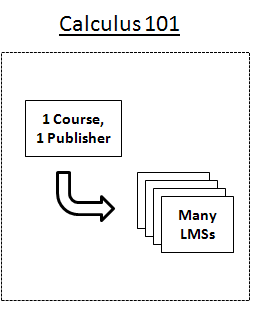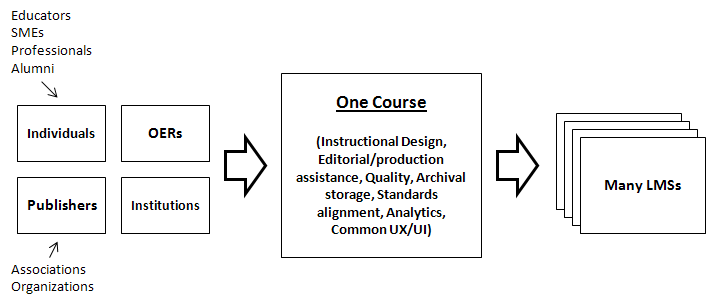Several times each year, professors all around the world undertake a ritual that dates to the invention of the semester. They update their course materials. Sometimes they do this on their own or with someone else teaching the same class at the same institution. Sometimes they download the latest slides available from a textbook publisher and tediously upload them into the Learning Management System one-by-one. Sometimes life gets busy, and they skip any updates for a semester. Maybe they find someone teaching the exact same course at another school and share the load with that person. This would make sense, since it seems insanely wasteful for everyone to reinvent the wheel and update their own copy of Calculus 101 to be ever-so-slightly different than everyone else’s. In fact I’d argue that most, single, logical courses are more or less the same regardless of the institution. In other words, the materials and lessons for Calculus 101 as taught at one institution are not really so different than those used by Calculus 101 as taught at another. Analysis of a million syllabi seems to confirm this hunch.

Today, for the most part, these classes exist as separate islands in different LMSs. Updating one does not update another, and any updates are largely done manually. Rarely do professors who teach in different LMSs collaborate – there is simply too much effort required to reconcile the glitches. Even with open standards to support “LMS agnostic” content that is transportable across LMSs, it’s incredibly time consuming even for a single instructor who teaches in different LMSs to ensure that they behave in the same ways across these systems. Ask any adjunct who teaches the same course at multiple schools with multiple LMSs. The types of test questions supported in each LMS might be different. Or the link from a given content item to another content item in the same course might break and need to be manually re-established. Or the weighting that you want to give to assignments in the gradebook might not work the same.

The textbook publishers, back in the day, created a way to make this process a little easier – provided that you were teaching with their textbook and only their textbook. They created content packages specific to each major LMS that could be imported with a click of a button. This addressed many of the compatibility and fidelity challenges. A modern-day variant of this concept links out to that publisher’s content (hosted on that publisher’s web site) instead of importing PowerPoint and other files directly into the school’s LMS. The primary limitation here is that the content still comes only from that single publisher.

The MOOC providers offer the most recent variant of a potential solution to this problem. They teach a single course on their single platform and allow anyone to enroll. Instructors can co-teach a class, and content updates are immediate and available to every participant. MOOC platforms also have the capability of aggregating immense amounts of learning analytics data that – hopefully, …theoretically… – could be used to foster better course design and support adaptive and personalized learning experiences. But this model does not fit the way that institutions enroll students into course sections and does not address such details as privacy controls over student data, which an institution can control for its own LMS. Students, should they want to take the course, have to register in a disjointed way on a different system and attend each course, potentially, in a different MOOC platform – Udacity, Coursera, edX, etc.

One Course to Rule Them All
Particularly as adaptive learning becomes more mainstream and the desire to pursue competency-based learning grows – the implication being that every piece of course content will need to be tagged with metadata and every click captured and analyzed – I believe that the level of effort required to build, configure, and maintain just one single online course may make developing that course a prohibitively expensive exercise, certainly for an individual instructor and maybe even so for a single institution. Our existing, individual, piece-meal methods of semesterly course content maintenance may quickly become unsustainable. Even the level of effort required to completely reinvent a single online course to be adaptive, capture the right analytics, and be aligned to learning standards is a significant undertaking. Our existing ways of hosting courses in disjointed ways across different LMSs – particularly as we try to aggregate and align standards and analytics data among them – are showing their limitations. In addition, particularly for the STEM fields, it is increasingly difficult to keep materials up-to-date given the pace of change. This is going to force instructors and institutions (and maybe even publishers, associations, alumni, subject matter experts, private companies, and others) to work together in new ways.
I believe that we will soon live in a world where universities and publishers and individuals collaborate to build a single “perfect course” for each logical course in each subject area – complete with every piece of possible and optional content, every remedial material, large pools of test questions, assignments, and homework activities. These courses will come pre-configured with all standards alignment and analytics capabilities baked-in and adaptive paths available for different learner profiles. Instructors will still be able to choose, tweak, and rearrange their course content – they just won’t have to start from scratch and will always have the latest, relevant materials available. Everyone will share in the heavy-lifting of building and updating each course. Perhaps different models of funding, coordinating, and distributing responsibilities for course development will emerge. These courses could then even be delivered through the same familiar LMSs of today – or from some other central platform.

While this seems ominously centralized, I’m not too worried about courses becoming too homogeneous. Assessment tends to be where courses differ the most. The experience of each instructor and the interaction of students are what tend to take each class in unique and different directions. There will be benefits to this new model and certainly some risks and trade-offs.
As for the actual content, I’m a big fan of separating course content from the system in which it is delivered. Many in the profession have reservations about the LMS (Learning Management System) acronym. These systems don’t really manage learning as they exist today (if one even agrees that learning can be managed). This concept would more accurately be called a Course Management System (CMS) – which is what most LMSs of today used to be called before Content Management Systems won out in this acronym war.
Over the years, a couple of LMS product features/concepts attempted to address this specific need. Blackboard’s xpLor attempted to provide a single, central repository where instructors could build and share courses and propagate updates easily. The problem with this product is that it provided a great empty shell – but someone had to build all the content, and licensing of proprietary content still proved to be a challenge. Moodle also created a feature called the Moodle Network which tried to syndicate and sync course materials across Moodle installations, but it was too buggy and was eventually removed as a feature. The problem of keeping distributed content in sync is actually a hard problem to solve when you begin to define what “in sync” means to different sets of users. For example some may always want the most recent copy of a piece of content, others the most recent copy reviewed and approved for use in their course, and still others a stable version as of a certain date.
There are also pockets where progress is currently being made in this area. Course Exchanges, which are becoming more frequently discussed, solve one piece of the problem. Usually this concept involves students and instructors from multiple institutions co-teaching and co-learning in the same LMS with the course credit flowing back to the student’s institution. Carnegie Mellon’s Open Learning Initiative seems to provide a model closest to what I’m suggesting. Some of their courses even integrate with existing LMSs. The largest advantage of CMU OLI’s approach is that it isn’t just a technological solution. The development of each course is wrapped with solid instructional design guidance, and revisions to future course versions are informed by data and feedback from previous editions of the course. I’ve seen schools collaborate on course development and contribute course revision assistance to the OLI courses as a means to sustain them. I’ve also seen schools pay what they would ordinarily pay a content publisher or producer to contribute to the initiative. This concept deserves further – and significant – investment.
Creating course content is not going to get any easier. To reap the benefits of advancements in adaptive technology (and even OERs), schools are going to need to find ways to share in the effort and expense of creating and maintaining course content. I am doubtful that the publishers alone will be able to offer and sustain complete, pre-packaged course solutions, each on their own. Even Pearson with its abundant market presence never got beyond a handful of it’s “My Lab” style courseware offerings and is struggling financially. I also doubt that learning platform providers creating “empty” adaptive products will succeed much in the long term. Instead I think these “perfect courses” are going to resemble something like the MOOCs of today. This trend will likely start with common introductory or high-enrollment classes where the largest returns on investment can be made to the most impact. Over time I see instructors who teach niche classes connecting with each other from across institutions and finding a place in this model as well. But the model we have today is incredibly wasteful and limits the progress that educational institutions can make in the long run.
This is a guest post authored by George Kroner